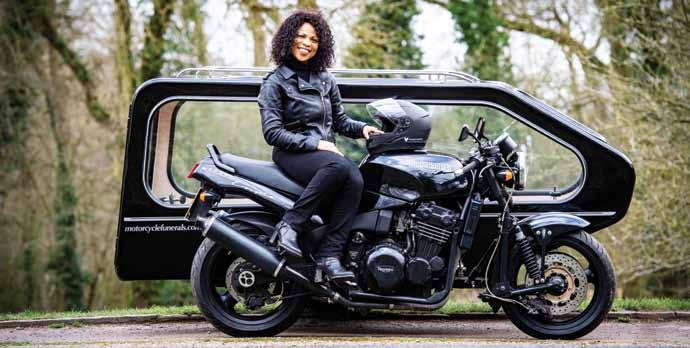












































































NEWS
03 Decarb Survey
What do BMF members think about ditching fossil fuels?
MOTORCYCLE RIDER IS PUBLISHED BY THE BRITISH MOTORCYCLISTS FEDERATION (ENTERPRISES) LIMITED
MOTORCYCLE RIDER
Editor | Peter Henshaw - editor@bmf.co.uk
Designer | Louise Hillier - design@bmf.co.uk
Advertising | Sheonagh Ravensdalesheonagh.ravensdale@bmf.co.uk
ALL BMF CORRESPONDENCE TO:

Helen Hancock, Administrator
BMF, PO Box 9036, Enderby, Leicester, LE19 9BE
Tel: 01162 795112
Mob: 07918 903 500



Email: admin@bmf.co.uk
COPYRIGHT: All material published in MOTORcycLE RidER is the copyright of the BMF. Use may be freely made of it without permission on condition that any material used is credited “reproduced by permission of MOTORcycLE RidER, the BMF magazine”.
The views of any contribution contained in MOTORcycLE RidER are not necessarily those of the editorial team or of the BMF.
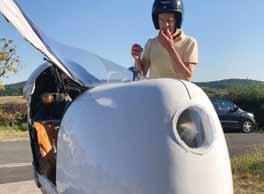
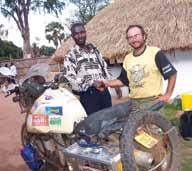
Chair | Jim Freeman
Finance Director | Howard Anderson
Member Services Director | Peter Laidlaw
Political and Technical Services Director |
Anna Zee
Communications Director |
Sheonagh Ravensdale
National and One-Make Club Forum Chair |
Stephen davenport
Administrator | Helen Hancock
www.britishmotorcyclists.co.uk

04 News
NMC and BMF’s Anna Zee and Emily Rochester have been busy...
07 FEMA Meet European riders’ organisations

Dear Fellow Rider reader, As this is the autumn issue, I’m going to give my usual homily about winter maintenance, in preparation for next year’s riding season. Making sure things like tyres and brakes get checked out, oil changed, fuel drained (if you run bikes with those strange carburettor things, which I do).

That really led me onto thinking about battery-electric bikes. One of their advantages, much touted, is their lack of maintenance. This seems to have come from the car world, where most drivers have zero interest in how their vehicles work and less than zero interest when it comes to looking after the oily bits. Most riders, traditionally, are much more interested in their bikes. Or are they?
I think back to the FEMA (Federation of European Motorcyclists Associations) Committee meeting in June, listening to a presentation by a female Danish rider/ entrepreneur who held the view that batteryelectric bikes had a higher approval rating amongst female riders than the traditional ‘oily handed’ brigade, precisely because they needed less fettling and fiddling. She summed up: “I don’t know how to fix my washing machine; I pay someone to do that, why should my motorcycle be any different?”
The thing is, most of the motorcycles that I’ve ever had, most of the time spent looking after them, hasn’t been spent on the engine or gearbox. The great gift of the Big 4 Japanese manufacturers was to make most engine maintenance very simple – oil, filters, plugs. E-motorcycles get rid of all that, but it doesn’t alter the fact that tyres, suspension, brakes and transmissions (from the power unit to the back wheel) all have some points of failure and maintenance. If your brake pads are down to the metal, or a fork seal leaks, it really doesn’t
matter what makes it go, it’s still a motorcycle. Then there’s the thorny topic of battery life. From watching numerous YouTube clips, from the likes of ‘James & Kate’, who are hard core EV enthusiasts, including motorcycles, I’d venture that the gloom and doom about battery durability is exaggerated. Things have moved on from first generation Nissan Leafs. Watching ‘James’ and a mate riding from Land’s End to John O’Groats on two electrics, was epic. Range is still an issue, but for how long? Incidentally, I’d recommend reading our Editor’s review of the charging situation, a few pages further in.
Thanks for bearing with me. If you have no interest in such things, I perfectly understand. As I may have mentioned before, my favourite bikes have included several ‘stink wheels’ and I love the smell of two-stroke in the morning.
Talking of change, we are always looking to adapt to the changing needs of our members, including yourself. You may have noticed that there’s a letter from Sheonagh Ravensdale, the BMF’s Comms director, inside the same envelope that this magazine arrived in. We have received emails and other feedback, about the magazine only being sent out as hard copy. If you’re interested in a PDF version, let us know, via Helen or Cheryl. If you only want a PDF, and no longer want the print version, that’ll help our carbon footprint too.
Stay safe, ride safe,
Q 1 I f t he sale of new f ossil-f uelled mot orcycles were t o be banned, what would you be most likely t o do? Please choose one opt ion
Q 1 I f t he sale of new f ossil-f uelled mot orcycles were t o be banned, what would you be most likely t o do? Please choose one opt
Q1 if the sale of new fossil-fuelled motorcycles were to be banned, what would you be most likely to do? Answered: 826 Skipped: 3
Q 2 Do you agree wit h t he current proposals on t he phase out dat es f or f ossil-f uelled mot orcycles? Please choose one opt ion
Q 2 Do you agree wit h t he current proposals on t he phase out dat es f or f ossil-f uelled mot orcycles? Please choose one opt ion
Q2 do you agree with the current proposals on the phase out dates for fossil-fuelled motorcycles?
Answered: 823 Skipped: 6
t ric or z ero-emis s on mot orc y c le s t raight away Ot her (pleas e s pec if y )
Q3 What may encourage you to purchase/ride an electric motorbike? Please choose all that apply
BMF Member Survey Gathering Views on Decarbonisation
Q3 What may encourage you to purchase/ride an electric motorbike? Please choose all that apply
Q3 What may encourage you to purchase/ride an electric motorbike?
Answered: 828 Skipped: 1
828 Skipped: 1
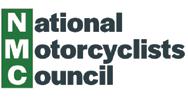
This has been the most extraordinary summer in politics that I can remember. A Conservative leadership campaign, combining with the long summer recess, followed by the death of a monarch. Then immediate political turmoil after the new Prime Minister entered Number 10. All these things conspired to put normal political life, such as it has been for the last goodness knows how long, on hold.
At the beginning of September, the NMC issued a press release calling for the work of government to properly restart (only to have HM Queen Elizabeth very sadly pass away the very next day). We highlighted several motorcycling-related issues that needed, and still need, urgent attention.
At the Department for Transport, the new Secretary of State Mark Harper has several challenges. The launch of a new road safety strategy was cancelled before the summer recess and there have since been calls from several organisations for this to be published. The NMC is keen to see progress on motorcycle safety and in particular seeks better support for motorcycling in a new strategy. Safety investment is all too often directed at the ‘favoured’ modes in transport policy of walking, cycling and public transport, with investment in motorcycle safety not having the same priority as it is for these other modes. This in turn has sustained a more vulnerable environment for motorcyclists than should be the case.
In relation to motorcycle decarbonisation, the NMC called for the Department to rethink proposals for arbitrary UK-only target dates for phasing out new petrol motorcycle production and instead move at a pace which recognises product and market developments internationally. We argue that the Government must take a genuinely technology neutral approach to decarbonisation and to support wider choice than just battery electric motorcycles. It is essential that every pathway to net zero is considered – including supporting the ongoing development of clean fuel technology for internal combustion engines. Security of fuel supply for older and classic vehicles as the new bike (and car) fleet decarbonises is also essential.


Both the BMF and NMC’s response to the Government’s decarbonisation consultation does appear to have been well received though. We have been invited to meet the new minister responsible for policy, Jesse Norman, as part of a roundtable to discuss the impacts of the transition to zero emission vehicles.
Work on other areas of motorcycling at the DfT also needs to gain impetus. These include the much-needed review and changes to the current training and testing regime for those seeking a motorcycle licence. The Department has yet to announce its intentions on vehicle tampering after the consultation closed nine months ago. Similarly, we have yet to hear what will be proposed on new e-scooter regulations. There are also areas relating to the review of Traffic Regulation Orders and the highways aspects of the Levelling Up and Regeneration Bill. Plus there are other statutory areas relating to motorcycle sport which also need attention. Promised activity within the Department to understand and engage motorcycling as part of the wider future of transport strategy also needs to make further progress.
Over at DEFRA, new Secretary of State Therese Coffey needs to get to grips with the next steps for the Landscapes Review now that the consultation has closed and confirm that there will be no new regulations to restrict the right to ride on both green roads and other (tarmacked) highways. In this area, joint working with the Land Access and Recreation Association (LARA) is resulting in very positive dialogue with DEFRA officials and we hope a way forward can be agreed which avoids new legislation.
The NMC has also called on the Cabinet Office to finally provide certainty to those transporting motorcycles in vans or on trailers across the EU border, so that riders can be confident that they won’t face unnecessary cost and bureaucracy.
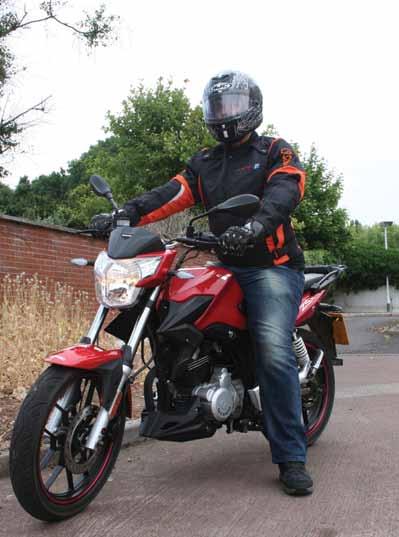
In relation to wider trade and business, the cost of living crisis is being exacerbated by rising prices for motorcycles, parts, service items and fuel. A chunk of that is coming from an increase in trade frictions and labour shortages, which the UK will need to tackle as part of the partnership and resolution mechanisms within the UK/ EU Trade and Cooperation Agreement. The same applies to work with other international trade partners, given the global nature of these issues.
Alongside this, we have stepped up activities as part of the NMC’s international partnership with FEMA and the FIM. BMF Director Anna Zee is President of FEMA so this strengthens links with the FIM on areas of international public policy that affect motorcyclists in the UK. As part of this, we have been present at some key rider and industry meetings that ran alongside the Intermot motorcycle show in Cologne.
One notable event during this week of activities was the ifZ motorcycle safety conference. Unlike many such events, this conference took a neutral approach to motorcycling itself, focusing on practical measures to support improved safety
through both technology and practical highways measures. Of particular interest was the range of technical work being done to address problems recently revealed by both FEMA and the BMF with autonomous driving technology not ‘seeing’ motorcycles, sometimes resulting in fatal consequences.
Another interesting event was an ACEM (European Motorcycle Manufacturers Association) roundtable on motorcycle decarbonisation which involved motorcycle factory owners and the European Commission. Manufacturers are heavily pushing an e-Fuels agenda at the moment, but the Commission’s attitude was hardly positive about this, favouring electric power and zero tailpipe emissions, rather than a more general net zero approach to vehicle decarbonisation. This whole area has become a major debate when it comes to the future of motorcycling.
So, all in all a very heavy agenda for the motorcycle lobby, but these are all issues fundamental to biking and how the future will look for us. Progress in all these areas does rely on a government that is focused on the job in hand. Ensuring that we get this focus in a positive way for motorcycling is what the NMC will be working towards in the coming months.
Craig Carey-ClinchFirst, the good news. Emily Rochester is now working fulltime as the BMF’s Government Relations Executive. She has been an enormous help over the last year while learning the job and is more than ready to take on more. You can expect to see Emily leading on this page in future.
Emily and I must thank all those who responded to the BMF survey on your attitudes to decarbonisation. Helen tells us that the size of the response was outstanding compared to most online surveys. We were able to use the results in our response to the Government consultation on decarbonising motorcycles (and other L-category vehicles).

The comments certainly covered a range of opinions. Some members accept that a phase-out of ICE (internal combustion engine) motorcycles will be necessary, while others were more grudging. Some had doubts about the necessary infrastructure or whether replacing fossil-fuel vehicles was really ‘greener.’ Quite a few are interested in alternatives to battery-electric or look for improvements to the current battery technology. Others are deeply sceptical that a phase-out of ICE is necessary. Thanks everyone for such a diverse set of views; we really did read them all.
So, what are we up to? One of the hot topics is Hackney Council’s proposals on motorcycle parking. Full implementation has been delayed until next year. With the NMC we are looking to work with the SaveLondonMotorcycling (Twitter) group to defeat this ridiculous proposal. An equally ridiculous proposal from the Greater Cambridge Partnership, £5 a day to enter a sustainable travel zone – same as for cars, is out for consultation until December.
Last year the BMF responded to a consultation on a proposal to set up a Road Collision Investigation Branch – a roads equivalent to the rail, air and marine investigation branches. The most recent meeting of the PACTS Vehicle Design working party featured a presentation from Glyn Wallis-Jones, who is leading the team to set up the Road Safety Investigation Branch. The meeting was assured that RSIB investigations will be targeted on themes identified from data, not by politics, which was a concern raised in our response.
Automated driving is a live issue, and there was a consultation on Automated Lane Keeping Systems (ALKS) a couple of years ago. Updated regulations now require that an ALKS-equipped vehicle must be fitted with sensors which can identify a motorcycle anywhere round the vehicle. The regulation also requires that

such vehicles report ‘detectable’ collisions but does not seem to define ‘detectable’. An effective sensor system may effectively avoid collisions, but we do not currently have confidence that a low-impact collision on the side of the vehicle will always be detected. However, it’s a start, and we have taken the liberty of recommending that remotely driven vehicles must be similarly equipped at the very least. (cf BMF response to consultation on remote driving).
A major concern is that of connectivity. Connectivity is going to be essential for many future vehicles in performing the driving task. Curiously, connectivity infrastructure does not seem to be part of the remit of the Centre for Connected and Automated Vehicles. Anyone who spends time in online calls knows that connectivity can fail, which does not inspire confidence in the prospect of remotely driven vehicles.
Shipping to Europe - we anticipate guidance on this will be available on the NMC website by the time you read this.
Trials for hire e-scooters have recently been extended until 2024. Following collisions involving both hired and privatelyowned e-scooters, we have supported both PACTS and the NMC in their calls for regulation, including proper construction and use standards. E-scooters were due to feature in the Government’s Transport Bill but this now seems unlikely.
Finally, we have always advocated for bikes in bus lanes, but this is an issue left to local authorities, requiring us to contact them individually. As we move forward, we hope to offer more resources and support to our reps and those who may wish to push this matter with their local authorities.
The FEMA Committee, consisting of the delegates from all the member organisations, the FEMA staff, and invited guests met in October generously hosted by IVM, the German industry association, at the Koelncongress, Cologne. Sixteen delegates and four guests plus staff attended physically, with a further five delegates via Teams.
FEMA President Anna Zee (also the BMF’s PTS Director), opened the meeting, welcoming everyone and listing the apologies. Due to transport problems, a number of delegates could not attend, the unluckiest being MCTC’s Soren Bendtsen who was delayed at the airport for four hours, flown to another airport, then returned back to his departure airport!
to become full members of FEMA. Unfortunately, they said that they couldn’t afford the fees, so their proposed membership was suspended, sine die.
The Mobility Tests were discussed and will be run again in 2023.
Following the request of the Committee in June, the FEMAFIM-NMC working group had reviewed the existing position paper on decarbonisation, but could not agree a revision. The meeting voted to support the existing position paper, without opposition.
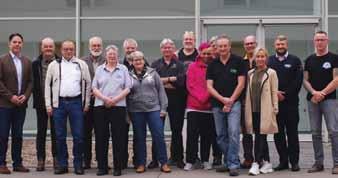

Several presentations followed, including by Reiner Brendicke, IVM. Also Martin Winkelbauer, from KfV, a research institute on road safety, on road markings and new infrastructure guidelines. The impact of this work has already been marked, both on motorcycle accidents and noise protests, particularly in mountain areas.
Jesper Christiansen, SMC and FIM E, about the progress of the ‘Vision Electric’ campaign in Sweden. The most interesting was the effect on non-motorcyclists – many non-riders tried the test fleet, (all funded by SMC, not the manufacturers), and found them to be fantastic fun, and unintimidating. Jesper had also made some technical discoveries, which were being incorporated by the manufacturers.
After the admin, Treasurer Jim Freeman (also the BMF’s delegate, attending on-line), made his report and introduced the draft 2023 Budget, to be approved at the FEMA AGM in February 2023. Given the very uncertain financial outlook, a number of options were suggested, which may well be amended.
There was an invitation for candidate Board members to put themselves forward for election in 2023. The entire existing Board offered to continue, however the President suggested that this would be the last year that she would stand for re-election, as she’d have been in post for 10 years in 2024.
Biker’s Voice Austria, after a year’s Observer status, were due
Dolf Willigers, FEMA General Secretary, made a presentation on the Tesla Autopilot and its Euro NCAP rating. This follows two deaths of motorcyclists at the hands of Tesla vehicles, which failed to recognise motorcycles from the rear. This appears to be due to Tesla dropping LIDAR sensors and relying solely on camera sensors, as a cost cutting measure. Dolf questioned Euro NCAP’S five-star rating of Teslas, particularly after previous instances of non-recognition of motorcycles.
The staff both made brief reports, on Secretariat and Communications activity. The meeting concluded, after the usual future meetings admin, at 14.29 CET.
WIN a year's FREE BMF membership
You’ve all been busy riding this summer, as just a cursory look at our Photo Comp reveals. Sunshine, rain and snow, whatever the weather, landscape or roads, you’ve been riding it, and we want to see more of your pictures. The winner in each issue of Motorcycle RIDER receives a free 12-month membership of the BMF.
The photo could be of anything – twisty tarmac, beautiful scenery, the local bike night – in fact anything with a motorcycle theme. The winner, plus the best selection of runners-up, will be printed in the next issue of Motorcycle RIDER
Send your photos to: editor@bmf.co.uk
Above: Celebrating successfully delivering 90 litres of fresh air (in the otherwise empty panniers and topbox) from St Just to St Ives by Tiger 900 “As a recovering COVID household, I thought I'd do my bit to help out for free,” says Andy warburton

Below: Can’t see the bike? It is there. ed Mackey’s Yamaha XJ6 hides aboard the Glenelg-Kylerhea ferry, Scotland, back in late June.

Below left: Dave Mullins’ Yamaha MT9 GT is dwarfed by its surroundings, the RSPB site at Haweswater in the Lakes. “As for a title,” he writes, “it could pay homage to a classic band from the ‘80s – In a Big Country?”

Right: Steve Pain says that he has two interests (cycling and motorcycling) but only one holiday, and this was the solution. He rode his Z1300 Kawasaki complete with trailer, six panniers and two mountain bikes from Pontypridd to Inverness, then to London before heading back to wales.

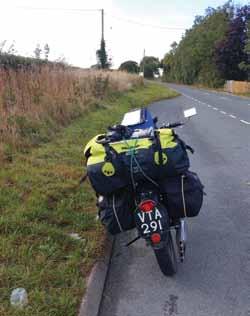
Below: Martin Bishop snapped his 1956 Velocette MAC (just visible under the luggage) by the Fosse way near Coventry, on his way to Donington Park for the BSB meeting – 400-mile round trip on a 15bhp classic bike, a fantastic ride.
Left: Sam Swire didn’t tell us where or when he took this snap of his 1998 Derbi Senda 50R, but it’s clearly a beautiful sunny evening. Below: So, two big V-twin customs, natural choice for a wet and snowy mountain road? Taken in Norway on the Nibbevegen 5 toll road, 1038m above sea level. “we went up Trollstigen,” explains Jenna wiggins, “then followed the 63 across snow-covered mountain tops in the rain.”

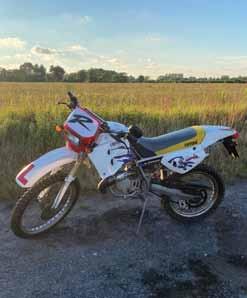
demonstrated the point by riding it the 140 miles from Potter’s Bar to Dorset for this interview, then home again without recharging. And he could have made another one-way trip without plugging in – the range is about 500 miles. It’s all about efficiency, of which more later.
Cedric might look like the archetypical eccentric inventor (he likes to go around barefoot) but underneath it all is a sharp, open mind. During World War II, his dad worked on the Colossus computer, helping to crack German codes, and the young Cedric was clearly cut from the same cloth. “I was interested in engineering at an early age,” he says, “thanks to a Ladybird book ‘Magnets, Bulbs & Batteries’ which explained how to make an electric motor from household items. So I built one.”
What does your bike do to the gallon? 40mpg? 50?
Maybe with a light right wrist it’ll get into the 70s, while the truly eco-minded on a geared 125 can easily broach 100mpg. Now imagine a bike that gives the equivalent of 1350mpg. Not only that, but it’s fully road legal, can top 60mph and the owner/builder has ridden it over 100,000 miles all over the country. Welcome to the world of Cedric Lynch – inventor of the revolutionary Agni motor, builder of the first electric TT winner and a biker since he was sixteen.
His home-built bike is of course electric, and astonishingly efficient, thanks to wind-cheating aerodynamics and the rolling resistance a Tour de France cyclist would be proud of. Cedric
No surprise then, that he studied mechanical engineering, but soon decided to drop it. “I got disillusioned; they were teaching us that the job of an engineer is to design the skill out of shopfloor jobs.” He did learn how to use machine tools, but the rest has been self-taught. By then he had already discovered powered twowheelers, starting out with an NSU Quickly before progressing to a 50cc Fantic (“a really nice sports moped”) and then a Yamaha YL1 100cc two-stroke twin. He’s still got the Yamaha and would like to restore it one day, but you get the feeling that electric bikes don’t leave much spare time for playing with petrol.
In any case, Cedric was clearly more interested in electrics, entering a 1979 competition run by the Institute of Mechanical Engineers – entrants had to build an ultra-efficient three- or fourwheeler which would run as far as possible on a pair of Lucas car

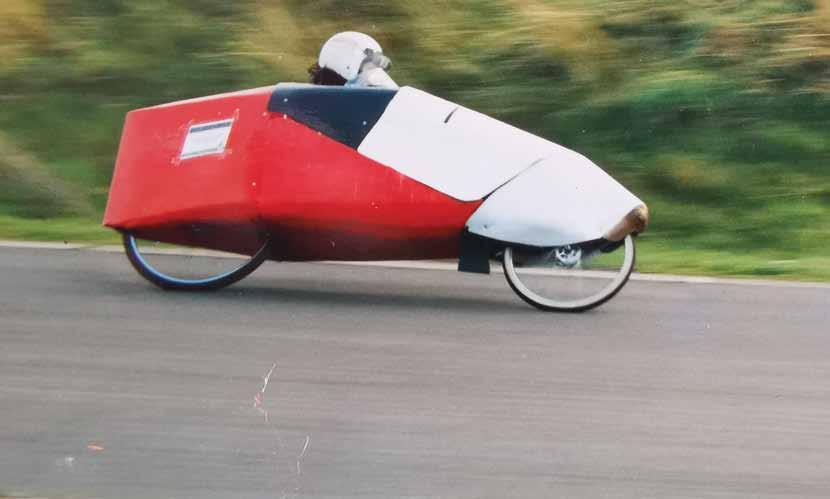
batteries. His entry managed 40 miles on Donington Park’s start/ finish straight, good enough for a close second place. A similar competition the following year allowed two-wheelers, and with a newly-built bike Cedric duly cleaned up.


But it was the Lynch motor which really cemented Cedric’s reputation for electric vehicle innovation. His invention (now named the Agni motor) is very efficient, even by electric standards, an axial flux motor with a spinning disc armature. Ferrite blocks are sandwiched between strips of metal instead of the usual copper windings. Copper rods are bent into a U-shape, the two legs fixed to the disc armature at 90-degree intervals, with magnets placed either side of the armature.
“I got the idea from baked bean tins,” says Cedric, “which I cut to a rectangular shape as the laminations. Because the magnetic flux is running along the laminations in one direction only, the motor is more efficient, with about 25% of the losses of a conventional motor.”
The bottom line is that the Agni motor can produce a lot more torque than a conventional motor, at lower speed. “With magnets
Above: Cedric with his original TT-winning racer
Above left: early days, and home-built electrics compete for an efficiency prize
Below: Arriving at Brighton in June 2022, during the London-Brighton eV Rally - Cedric won his class…

both sides of the armature,” says Cedric, “it halves the speed and doubles the torque. Running more slowly means frictional losses are lower and there’s less of an issue gearing the motor down to wheel speed, which is another source of losses.”
In the 1980s, London Innovation helped patent the motor, though early plans to productionise it failed – back then, electric motors were associated with milk floats rather than high-tech cars and a zero carbon future, though Cedric did use one of his motors to set a new electric speed boat world record in 1999.
Unable to make a living as an engineer, Cedric got a job in a newsagent, where he recruited 11-year-old paperboy Arvind Rabadia as his (lightweight) team rider. The team worked well, winning a string of efficiency competitions using Cedric’s homebuilt two- and three-wheelers. Thirty-odd years later, they’re in
business together – Arvind heads up Agni Motors, which builds the motors in India, while Cedric does the R&D. The motors go for all sorts of uses, including go-karts, for which battery power has several benefits – with no fumes to worry about, indoor tracks don’t need complex ventilation systems, and no one complains about the noise…
So far, Cedric hadn’t built an electric race bike, but that all changed in 2009 when TTxGP – the electric TT – was first held. The Isle of Man Government entered into the spirit of the thing, offering a £10,000 prize to the first electric race team to lap the Mountain Course at over 100mph. Naturally, Cedric jumped at the chance, sourcing a Suzuki GSX-R chassis and getting to work. He decided to use twin Agni motors, and explained why – to win a TT, they needed more power.
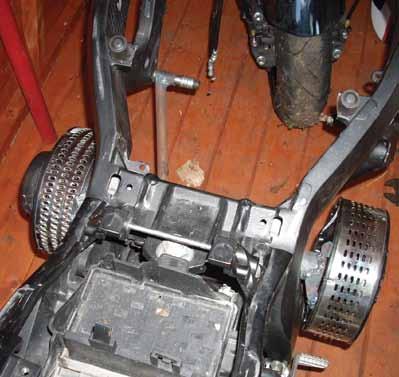
“We needed more than we could safely get from one motor. Each motor had its own controller, set so that the torque (not speed) followed the throttle position; this meant that the current was similar in each motor even if there were small differences in the throttle potentiometers, controllers or motors, or differences in the temperature of the motors. Also the motor mounts are made from quite thin steel sheet so that the motors can self-align to some extent if the alignment is not perfect.
“The TT scrutineers required me to do calculations of the stress and factor of safety in the motor mounts before they would allow the bike to run. These calculations showed that the mounts could take about 17 times the force to which they would be subjected at full torque. The bike has been in many races since, and the motors have still not fallen off!”
With Rob Barber riding, Cedric’s first ever TT racer won the inaugural TTxGP by a country mile, lapping the course at 87.434mph. “A lot of people were rubbishing the whole idea of
an electric TT,” says Cedric, “saying it would be like watching milk floats, but that changed when they saw how quick the electric bikes were. The manufacturers sat up and took notice too, and the following year Suzuki lent us two bikes minus engines – we finished second and fourth that year.” Since then, the e-TT bikes have gained pace year on year. Michael Rutter’s current electric lap record of 121.91mph remains unbroken to date, though the organisers decided not to run the electric TT this year.
Exciting as setting TT lap records is, Cedric’s heart lies in the tireless pursuit of ultimate efficiency. Electric bikes are naturally efficient. Ridden briskly, my Zero DS uses around 100Wh/mile, the equivalent of 337mpg – more gently, it can manage 75Wh or less (over 450mpg).
But that’s still not good enough for Cedric, who thinks today’s e-motorcycles could use a lot less energy than they do. “The current generation of electric bikes are quite inefficient, partly down to aerodynamics, but the biggest problem is tyres. Most bikes, at least in the West, are designed to get round corners with your ear dragging on the ground, hence the very wide tyres with sticky compounds. These are great for grip but have poor rolling resistance.
"On aerodynamics, there’s plenty of improvement while keeping a conventional riding position – look at racers and some scooters from the 1950s – you can do quite well with an upright riding position.”
Cedric’s home-built electric is the result of all this thinking, with great attention paid to both aerodynamics and rolling resistance. While the bodywork, a combination of glassfibre and plastic sheeting, might look a little home made, it certainly helps his aerodyne slip through the air – it sips electricity at just 25Wh/ mile, or over 1300mpg.
Cedric hasn’t abandoned petrol power, arguing that something like a Honda CB500 with half the losses due to wind and rolling resistance could also halve its fuel consumption, if gearing was radically raised to suit, but acknowledges that improved mpg isn’t a priority for many. “The thing is, petrol is so comparatively cheap and gives so much energy per litre that people don’t pay much attention to efficiency, so the motorcycle industry continues to go its own way.”
But like many of us, he’s accepted that the transition from ICE to electric will happen. “We’ve got to go electric, but we will need a battery cooling system to enable fast charging, which you really need if you are going to go touring – there are technologies now that will enable 10-minute charging – the problem with bikes is always bulk and weight. Electrics have come a long way. The current lithium-ion batteries have ten times the energy density of the old lead acids, and there’s lots of work going on improving range, charge times and battery life. There’s definitely more to come.”
Well autumn’s arrived so it’ll be quilted linings into our riding suits, on with the thermals, and for those of us who persist in riding old nails in all weathers, the liberal application of WD40 all over our cycle parts.
Except that in my case I’ve pretty much stopped riding in all weathers if those are bedevilled by temperatures that only hover just above 0° centigrade and/or feature more than half an hour of driving rain. Yep, I’ve become an unrepentant fairweather biker and anyway, that’s why God invented cars.
However, after learning the hard way (ie by willful neglect) over the past few years, I’m now making preparations for my motorcycles, if not myself, which will hopefully see them safely through the British climate’s more malevolent propensities. To be precise, I’m buying a pair of battery conditioners.
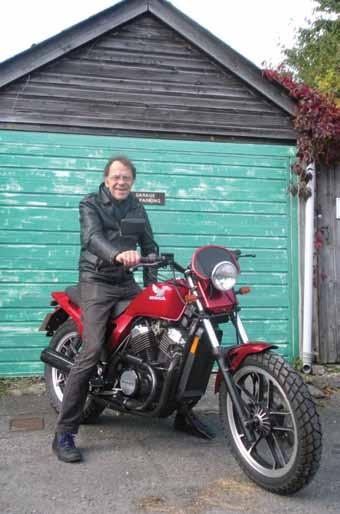
Yes, yes, I know we’ve all been told a zillion times that bikes left un-run for months on end will lose the charge in their batteries, but because all my bikes are of an age where there aren’t any digital wotsits that might otherwise drain theirs, albeit at a weeny rate, I’ve not really bothered with them. (The exception to this is my BMW K75S which has a digital clock, more on that later).
Another reason for such indifference to current drainage is that come the Spring when I’ve decided it’s time to unSORN my pride and joys, only to find the battery too weak to turn the engines over...well, I’ve long owned a perfectly good (car) battery charger. Iwill admit to buying a single Yuasa charger/conditioner years ago at an autojumble, and after having to stump up for a battery big enough to spark a small car for the aforementioned BMW, it’s been used almost exclusively for that bike, although I’ve occasionally applied it to the rest of my motley fleet when the whim took me. Not often enough of course, for the two Hondas and the 2018 SWM have each needed a new battery this past 18 months courtesy of the ever-cheerful Tony Huck at Maitland Racing.
But that, hopefully, will be the end of that for I’ve just sold the SWM and am buying a couple more conditioners, though as with just about all things motorbicycling these days, that comes down to quality and effectiveness versus cost. As far as I can tell (with the help of Mr Google), Yuasa no longer makes that £15 autojumbled charger. With its 5–6Ah output, automatic cut-off when the battery is fully charged and charge and/or condition LED indicators, it worked well enough, so I wasn’t entirely surprised to find that similarly rudimentary devices are now being advertised for as little as £12 on fleaBay.
But having learnt the hard way that cheapest is rarely ever the best bought online, as I’m going to be nowhere near Mr Huck’s gloriously old-school North London emporium any time soon, and as the nearest dealer to me here in mid-Wales is over 25 miles away, online it must be.
And of course the choice is madly extensive – from the bargain-basement £12 jobbies that look like a cross between a fag packet and a few chunks of Lego, to ninety quid items that do everything to and for your battery and probably make you a cup of tea whilst they’re at it. The average price for what appear to be decent, feature-rich charger/conditioners is around the £30 mark, but it’s impossible for a thicko like me to know whether facilities such as an ‘hourly voltage check’ or a ‘desulphation stage test’ are worth paying a lot extra for. At the time of scribbling, I’m tempted to go for one of Oxford’s range of battery conditioners as I’m a loyal consumer of their generally trustworthy products, but even they range from £36 to £90 and bamboozle me with their many features.
Now, if I could go to a friendly bike dealer and ask him or her to explain what’s best for my needs and wallet from the undoubtedly much smaller choice than I’m confronted by online, how much happier I would be. QED my friends, QED.
What’s the biggest thing putting you off buying an electric motorcycle? According to the BMF’s recent survey on decarbonisation (see page 3), range tops the list (no surprises there), followed by high purchase price and access to charge points. So just how well are e-bikes served by the public charging network? Is it fit for purpose or a genuine barrier to the practicality of long distance electric biking?
The first point to make is that none of this applies to the vast majority of electric bikes on UK roads. Last year, just over 6000 electric two-wheelers were sold in this country, but nearly all of those (about 5800) were mopeds, scooters and A1-class motorcycles such as the Maeving or Super Soco. These have smaller batteries (often lift-out for charging), tend to be used for commuting and, crucially, can charge via a domestic threepin plug, so in other words just about anywhere. Owners usually charge at home, overnight, job done.
Things are trickier for bigger electric bikes – Zero, Energica and the Harley Livewire. All of them can charge on a three-pin socket, given a suitable adaptor, but that’s very slow, and for
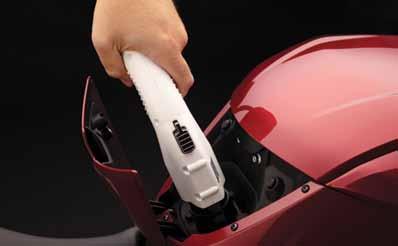
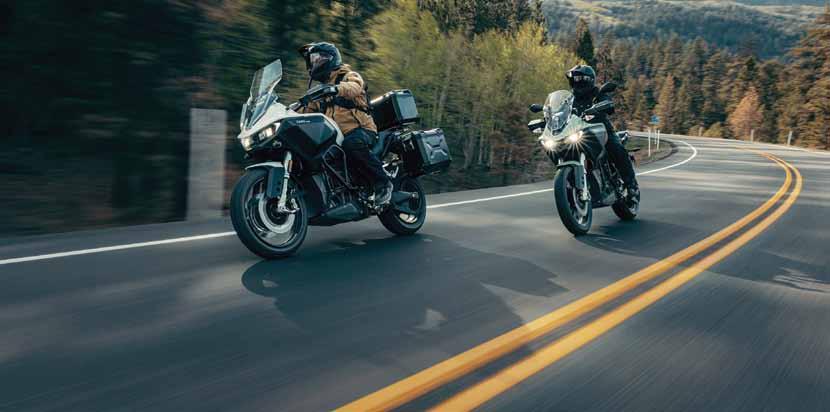
rapid charging they either use a Type 2 AC or CCS DC connector. A typical 20-80% charge after 100-120 miles or so will take about 40 minutes on Type 2 or less on the faster CCS – not as quick as topping-up a tank, but if you like to have a break every couple of hours, quite doable. But are the chargers available.
There’s no doubt that the UK’s charging network is growing fast, and we’ve all seen the charge points popping up at supermarkets, filling stations and car parks, hotels and garden centres. There are even a few new electric-only forecourts now. Ryan Duffy, who wrote about this very subject for Motorcycle RIDER two years ago, says: “Yes, there has been progress since 2020, and the Gridserve Braintree electric forecourt is a good example. There is still a lot to be resolved, but there is work ongoing.”
According to Zap-Map.com (a brilliant resource which gives the location and status of every charge point in the country), as of September 2022 there were nearly 35,000 chargers in just over 20,000 locations across the country, with more being added every month (1126 in September). Type 2 connectors are one of the most numerous, with 27,500 of them, increasing at about 30% per year. Melanie Shufflebotham, co-founder of Zap-Map, said: “We’re expecting that trend to continue, and we’re seeing an increasing number which provide a faster charge. There’s still more to do in expanding the network but we hope this will encourage riders to make the switch to electric bikes.”
That sounds great, though the geographical spread is heavily skewed towards the south east. Greater London alone is home to nearly one-third of them, while the rest of the south east grabs another 13% - the rest of us share the rest – see www.zap-map. com for the live map.
Oli Knights is Head of Sales at Norfolk-based English Electric Motorcycle Company, one of Britain’s few electric-only bike dealers – what does he think? “Generally speaking, the issues are
the same for motorcyclists as for car drivers, except that some chargers don’t have any shelter, which is useful for bikers if the weather’s not good. On the spread and availability, it is a growing network and there are plenty of options to charge, depending on what you need. What we find with bikes compared to cars is that journey length and the need to charge is less of an issue – we tend to travel shorter distances so don’t use the public network so much.”
One challenge that riders and drivers share is that the network has grown like Topsy, with many different private operators, many of whom insist you have to use a particular app or card to make use of their chargers. BMF member Tom Duncan, who has been running a Zero DSR since 2018 and knows a thing or two about charge points, thinks the result is a shambles: “I live in Linlithgow and was planning a ride down through England. Downloading all the charging apps I could find took up six screens on my iPhone!”


Since July 2022, all new rapid chargers have to be open access – ie anyone can pay with their contactless bank card, with no membership needed – but many of the older chargers aren’t, so it’s not exactly like pulling into any filling station you fancy.
One thing is different for bikers though. Most Type 2 chargers are just a socket, so you need to bring your own cable, which isn’t a problem for a Nissan Leaf driver, but can be if it’s taking up valuable topbox space on a bike. CCS chargers have a tethered cable, just like a fuel pump. “We provide every bike with every cable it needs,” says Oli Knights, “and a two-metre Type 2 cable isn’t huge – it’ll comfortably fit in the cubby that comes with the Zero, or in a backpack, so it’s not a huge problem.”
Tom Duncan’s experience has been mixed. His Zero can manage 80-140 miles on a charge, which is plenty for business trips into Edinburgh or (at a pinch) Glasgow, and at motorway speeds, but he’s found riding further afield can be a challenge.
“We’re a long way from a reliable network. Frequently chargers are out of order or simply switched off. Sometimes there’s a queue, and you don’t know how long the driver in front will be. Cables are a pain in the butt, and I carry three so that I can charge anywhere, but it’s not like rolling up to a petrol station. At the moment, the charging network is what’s stopping me from selling my BMW GS and going electric-only. I think it’ll get there, but it’ll take years.”
Of course, he loves riding his Zero, praising its smooth, torquey power delivery and rapid acceleration. “I let my MOT tester have a ride and he came back with a massive grin!” Oli Knights, who has given plenty of first-time electric riders their first go, agrees: “We’ve never had anyone come back from a test ride and say that was rubbish; they come back with a big grin. What puts them off is the high-speed range and the initial cost.”
As for the charging network, keeping off motorways (or least below 70mph) makes a big difference to range, and everyone seems to agree that riders should stop for a charge when the battery is down to about 30%, which gives enough juice to find
Above: Remote monitoring is a feature of some electric bikes
Below: The chargers are there, but often you will need to bring your own cable
another charger if the one you’ve chosen is busy or out of order. “Yesterday a colleague and I rode down to London and back on Zeros,” said Oli. “250 miles, stopping twice for shorter top-ups – I’d always recommend shorter charges and doing the rest at home, as it saves time and is cheaper.”
The bottom line though, is that UK’s charge point network needs to see a lot of improvements before it’s something we can truly rely on, and I say that as a fan of electric motorcycles with a Zero DS in the garage. It’s not just the number available, but they all need to be reliable, with their own tethered charge cables and (crucially) be open access, so that anyone with a contactless card can use any charger. Until we get that, the electric transition will take a lot longer than it needs to, or should do.
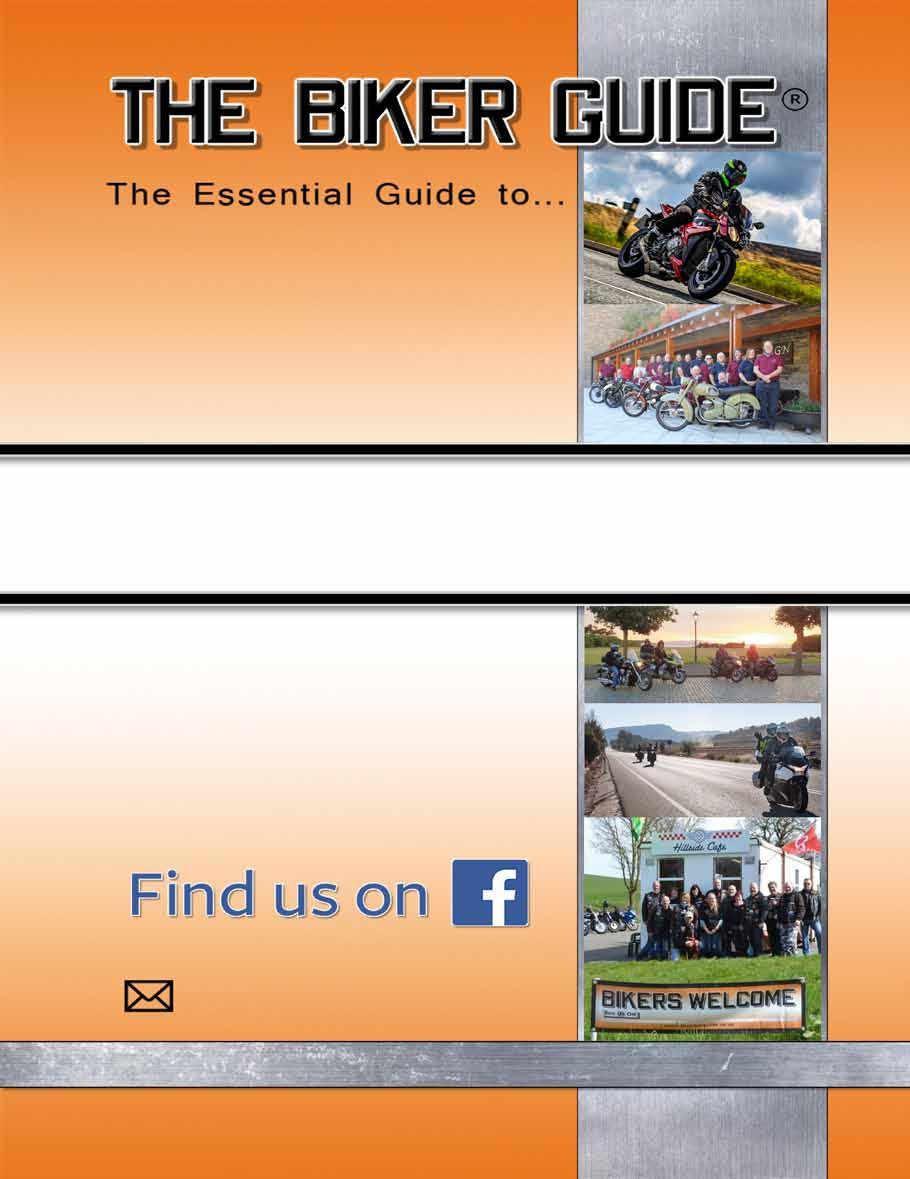


Anyone with a full motorcycle licence should consider advanced motorcycle training, whether for the first time or as a refresher. It will help to improve your own safety as well as your confidence while riding and will generally make you a better rider.
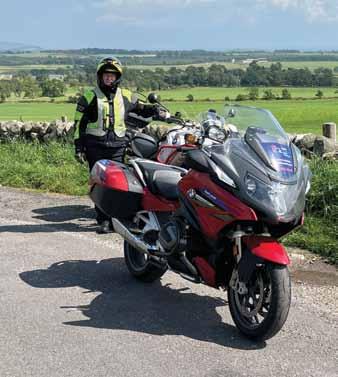

My experience has been limited to the IAM course and the BMF’s Blue Riband training. The roots of advanced motorcycle training are the same for both – Motorcycle Roadcraft and the Highway Code – so to get the most out of any training it is necessary to have read and to have an understanding of both these essential books. Undertaking Skill for Life training with the IAM is an excellent way to do just that – I have taken both that and IAM Masters.

Earlier this year I decided to undergo Blue Riband training with Colin Blackley of Dart Advanced Rider Training in Dumfries. Colin is a very experienced rider and delivers both the on-road and classroom training in a relaxed, unhurried manner.
For the record, I am an ordinary rider but I do have a keen interest in doing what I can to ensure my safety when riding, hence my decision to take both IAM and BMF schemes. There are two main differences between them, one being that Skills for Life takes place over an extended period, and you have time in between sessions to practice and hopefully perfect your riding techniques. By contrast, Blue Riband training is an intensive day and a half of on-road training and a couple of hours in the classroom. The other difference is that the IAM scheme focuses on guidance for your riding, while Blue Riband gives actual instruction throughout. To get the most out of the BMF Blue Riband training, it is helpful to have completed some previous advanced rider training such as IAM Skill for life or RoSPA advanced motorcycle training.
As I already had a good grounding in Roadcraft as a result of the IAM course, I was able to benefit from the Blue Riband training fairly quickly. Colin was quick to see flaws in my riding and was equally rapid in giving clear guidance and instruction on how to address them.
One area I needed to work on was the use of acceleration sense in the twisties. Colin noted a lack of consistency in that situation and gave some suggestions while we were riding on how to deal with it. The effect was almost immediate, smoothing out those wrinkles in my riding. There is of course still much to work on, and there probably always will be!
Riding a motorcycle is comparable to flying an aeroplane. If you don’t fly regularly, your skill set falls away, sometimes with unfortunate consequences. It’s the same in motorcycling, and advanced training will help to keep up your riding skills and confidence, restore skills and remind us of our vulnerabilities. Do some advanced training, it might just help to save your life.
In 1963 my first proper job was in Rhyader, 200 miles from my home in Harlow. Transport was essential, a car unaffordable and public transport near to non-existent, so it would have to be a motorcycle. I learnt to ride on a 1948 125cc James with a two-speed hand change gearbox. If nothing else, it taught me how lucky I have been most of the time.

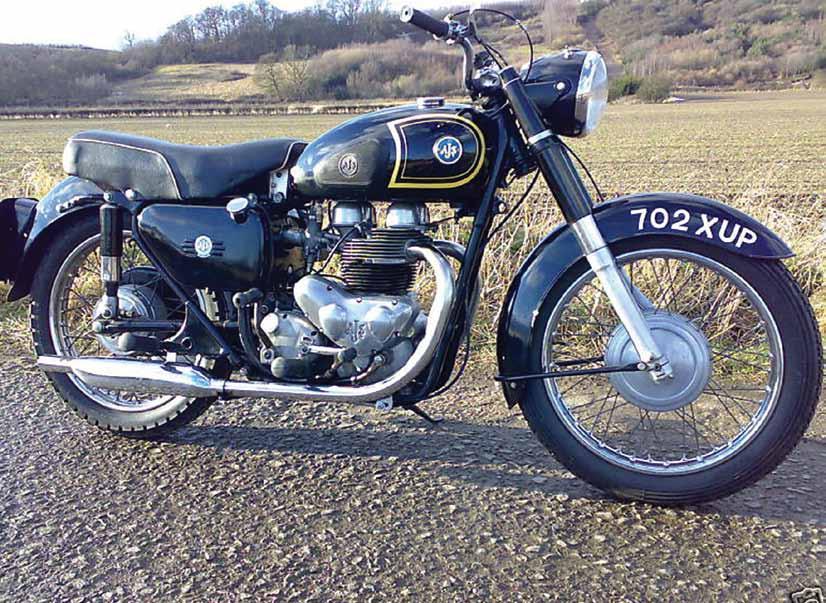
Once I’d passed my test, my mother bought me a used Ariel Leader, which was just about the most sensible thing on two wheels for the long-distance commuter who wasn’t an enthusiast. It had generous weather protection, built-in panniers and flashing indicators long before their time. The Leader also did its job, getting to and from Wales in reasonable comfort, until one fine day in 1965 when the engine blew in a comprehensive way.
By this time I was working back in Harlow, and much enthused by motorcycling, but faced with a major rebuild and the Leader’s staid image, it was rolled into the shed and emerged six months later, tuned and café-racerised. I soon learnt the trade-off between performance and engine life for 1950s British twostrokes, getting very adept at swapping engines – eventually I had three on the go.
Above: An AJS 650 like this was John's first big bike Left: John turned his into this
I soon got fed up with that and decided that a larger engine which didn’t have to work so hard might be preferable. So I bought an AJS 31CSR 650. It was a basket case – several important bits had been nicked off it and the engine was seized, and it cost me £12 10s.
Half a can of Plus Gas down the plug holes and a bit of time got the engine turning, while a few visits to the scrappy found the missing bits. Much learning followed about large 1950s British
bikes. The frame was a beefed up pedal cycle design – engine torque would flex it one way, and the rear brake the other. On the other hand, there was little danger of the front brake flexing anything at all. The AJS got the café racer treatment, though beneath the finery it was still the same overweight, evil handling, brakeless death trap. To be fair, I may have been asking it to do things for which it was not designed.
In any case, I had seen the future. Norman Jackson was ‘Leader of the Pack’ and he rode a Norton 650SS. I wanted one, though annoyingly Norton had just gone over to making the Commando (far beyond my budget), but I used trade contacts to collect the bits and over the winter of 1967/68 built a 650SS.
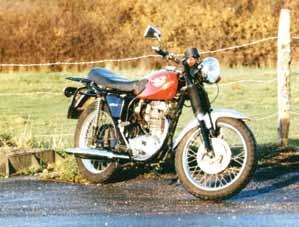
At last, here was a classy piece of kit which was also very quick by the standards of the day – even the brakes worked a bit. I sold the AJS for £110, (the most profit I’ve ever made on a motorcycle) and the Norton became my primary transport for the next couple of years. Valerie and I went touring on it in Christmas Tree mode with full camping kit – if it fell over all the kit had be unloaded before I could pick it up. Hailstorms in Cornwall, midges in Snowdonia, broken collar bones in Cheddar. One long saga of delight.
Eventually it turned out that the first bits of a 650SS to wear out are the main bearings, but it was still my best bike yet. I even went sprinting on it, and have a picture of Valerie and me at Duxford in 1970. The bike had just done a standing quarter-mile of 13.31 seconds with a terminal speed of 106mph, and 124mph at the end of the standing kilometre. I owned nothing to touch this level of performance until my first Japanese 750 in 1984.


With the Norton engaged in all this sporting activity and spending quite a bit of time being worked on, there was a vacancy
Above left: 650SS and all the gear – it was fast
Above: John and Valerie with the Norton after that quarter-mile
Top: CZ 175 was reliable...below 55mph
Above: Fastish, good handling, good brakes, but BSA B44 was less than dependable
Left: Honda ST70 was “good in the snow”
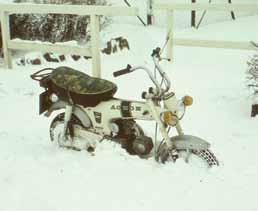
for a ride to work hack. Something simple, reliable and cheap. Something like a Matchless G80
This was my hack transport through the early 1970s: eminently sensible, quick enough to keep up on a motorway, not very thirsty and easy to maintain. It was much better behaved than the AJS 650 which had virtually the same chassis, as the smaller engine was not making unreasonable demands. It became covered in flower stickers, but happily there isn’t a picture of that.
Then the Norton was sold to fund a beach buggy. I went surfing and actually gave up bikes for a couple of years. We ran a car each until the first oil crisis made that too expensive. One of the reasons I had stopped riding was that I had been falling off too often. So aiming for safety and economy, my next bike was a CZ 175 trailie. It would cruise all day at 50mph, but go for 55 and it would seize, though to be fair, it would unseize as soon as it cooled and never seemed to suffer as a result. It took me through the wonderful summer of ’76.
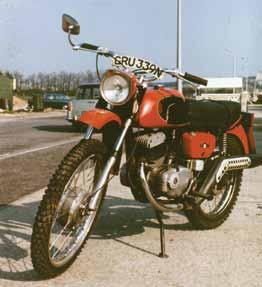
But it only lasted ten months before the Mr Toad in me got loose again and demanded more performance. Still wanted something small and light, so traded the CZ for a 1967 BSA B44, which I kept until 1980. Little, light, agile, surprisingly swift, blessed with the best brakes I had known so far...but appallingly unreliable. The BSA was great on a good day, it’s just that there were never enough of those strung together.
By 1978 we were on our first mortgage and times were tight, while the BSA was in bits once again. No functioning wheels and the need to get to work led to my lowest ebb on two wheels, a Puch Maxi. It was truly horrible, every bit as vile as the surviving picture.


Meanwhile, the BSA engine internals had been expensively replaced with CCM bits, and reliability improved. But the virtues of a little commuter were not lost on me, and slightly improved finances enabled the purchase of a Honda ST70, one up from a Monkey Bike. In white with a green paisley seat, it wasn’t my chosen colour (I had decided by now that all motorcycles should be black), but was excellent in snow.
The car had gone by now (after bleeding us dry) so we needed a motorcycle that would tour two-up and carry stuff. I bought a 1971 Triumph Tiger 650. Really comfy this was, and we put a lot of miles on it as our main transport until 1983. It took us to the Isle of Man (and round the Mountain Course in less than
Far left: Comfy, fast and a sub30-minute lap of the TT course – Triumph Tiger 650
Left: Yamaha SR500 was adapted to hill climbs
Left: ZZR600 was smart, fast, practical
30 minutes) and an engine rebuild took a weekend. But then my job went broke and the Triumph needed a major refurb – with no money, a new job and no time, it wasn’t going to happen.
Then my mother died. We had family in Harlow, Gloucestershire and Pembrokeshire, while I lived in Weymouth, so I was going to be doing a lot of miles in the year ahead – I traded the Triumph for a BMW R45. It did very well, and I put over 30,000 miles on it that year, just kept it fed with petrol, oil and tyres, and it just carried on. It had many virtues and never let me down – I liked the reliability, the shaft drive and electric start. But I never learnt to like it. The BMW was like a good washing machine.
What to do next? For the first time in my life I had some capital. It was 1985 and I was doing a bit of courier work at the time. Couriers swore by Kawasaki GTs – unbreakable they said. So I tried one, and went on to have three of them over 170,000 miles.

At last, here was something as quick as the Norton – much bigger and heavier, and it needed 80bhp to do what the Norton did with 55, but that’s progress. What it did not need were new main bearings and piston rings every 10,000 miles. In fact, I have never been inside the engines of any of my GTs. Commuter, tourer, toy, hill-climbs, sprints, holidays, Lands End to John O’ Groats – a versatile machine and comfy with it.
By this time my Honda ST70 was getting a bit tired and rattly, and a colleague bought it, but what tiddler should I have next? It was a Suzuki GS125, bought 1986 and kept for five years. Over 100mpg and the only bike I ever had nicked. Somewhat embarrassingly I came closer to dying on this bike than any other – more on this later.

Meanwhile, my first GT750 Kawasaki was getting scruffy (too much despatching) so it was upgraded to a newer one. The latest GT still wasn’t black enough for me, so I painted it to suit – shame about my red leathers at the time. I was doing the odd hill climb by now as this form of racing appealed to me – having the track to yourself made it unlikely you would be part of someone else’s accident. And riding the race bike to and from meetings helped retain sanity.
After a couple of seasons on the GT750, it was clear that people on little singles were doing most of the winning, so a more suitable bike seemed desirable. I bought another basket case, a Yamaha SR500, the road version of the XT500 trail bike. It entered the garage with a 19-inch front wheel, weedy front brake, strangling exhaust system and a 191kg pork problem. It emerged with 17-inch wheels (quick steering, sticky tyres), an RD350 front end, scrambler exhaust system with a few extra baffles, and weighing just 128kg. I could pick it up back then as well. The Yamaha did hill climbs and sprints, taking me to and from them into the bargain.
Then in December 1991 I was squashed by a careless car driver whilst riding the little Suzuki. The damage was serious and I was lucky to be alive, and very lucky to mend as well as I did. The GS was a write off, the Yamaha was sold and there would be no more competitive riding for me. Not only that but the GT750 needed quite a bit of work to run again after 18 months of neglect – bikes just hate that. Finally, in July ’93 I was back on the road and down to one bike. For the minute. Getting damages takes a while.
In August 1994 I met a Kawasaki ZZR 600. Black and shiny it was, all over, and goodness me it was fast, if a little wallowy around the twisties. But it was comfy, well suited to my short legs and could carry stuff for touring. In fact, it was so accomplished that that was me sorted for a while.
In February 2002 I replaced it with a Triumph Sprint RS. The grunt of the 955cc triple was quite a change after the rev-hungry Kawasaki, but the Triumph was finished in an orangey red so vile that I was forced to drop it almost immediately, so as to have an excuse to have it sprayed black – that was more like it.
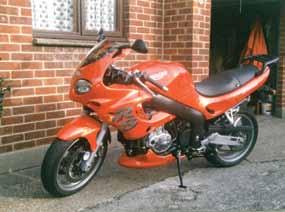
By this time I had been looking to replace the GT for a while. Over 100,000 miles and everything was getting ratty. The trouble was, Kawasaki had stopped selling them in the UK in 1990, and all the ones I looked at were worse than mine. I settled for a



Above left: First Hinckley Triumph –grunty, but he hated the colour

Above: GTs became a mainstayJohn had three of them
Above: Ariel Leader made a practical long distance commuter
Right: Somewhere in this blurred black & white snap is a café-racerised Leader
GT550, the 750’s little brother. Not as good performance wise, but economical. It was also nearly new and refused to fall over so it was quite a while before I could justify getting it sorted. That is, having it painted black – also fitting a 4-into-1 exhaust and GPZ fairing.
Another stable period ensued until 2008 when the Sprint RS appeared to be getting taller – either that or my legs were shrinking. That same year, Triumph announced the Street Triple, much the same performance but 30 kilos lighter and 50mm lower, plus wonderful reviews. Hence Max, an all-black triple which is undoubtedly the naughtiest motorcycle I have ever owned. In fact, it’s good that nothing like this was available in my youth, or this might have been a much shorter story. As it was, my motorcycling career ended in 2017 when my damaged leg began acting up, requiring further surgery. Very reluctantly, I sold the bikes, sent my riding gear to a good cause and filled the empty space in the garage with toy aeroplanes – very sad, but it seemed like the right thing to do.

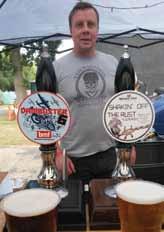
The prelude to Dambusters for me was again a visit to the Lincolnshire Aviation Heritage Centre for East Kirby bike night on the Wednesday, where we set up the BMF gazebo and watched Lancaster bomber Just Jane taxiing on the grass – well worth a trip and the small entry fee: www.lincsaviation.co.uk/
Thursday was set-up day for the rally at Thorpe Camp Museum, only a few miles from East Kirby. Our hard-working marshal volunteers were already there, and deserve a special mention for their dedication on gate control, camp pitching, toilet cleaning and refuse clearing. The museum was handed back as usual clean and on time for opening to the public on Sunday, with thanks to all rally goers for making it a success.
Above: FIM Motocamp - French schoolchildren greet the UK team.

Vive l'entente Cordiale!
Left: Heavy security at the Dambusters
NAAFI
Below left: Dambusters featured scary monsters and its own ale.

The period NAAFI did a roaring trade in homemade cakes which always sell out in the rush – so much so that we had security on the door, thanks to Little Fairy and Big Fairy. Funny games on Saturday were organised by Cathy and Pete Selby, aided by a slurp of ale and good music from the Gypsies – a new line-up with fiddle in the group but led as always by Gary Wilkes.
At the BMF gazebo we concentrated on selling the new Weebles BMF T-shirts – some of the income from these goes to the charity Mental Health Motorbike. See the BMF website where you can still order one by post. Our partners Thorneycroft and Bikesure sponsored the Rally marshals and stage, respectively, while our other partner, Motoring Assistance, may be involved in future. Look them up on the BMF website for contacts and how they can help members.
There were lessons to be learned in changing from the Covid-restricted 2021 rally to a larger attendance and although everyone was helpful in squeezing in, the numbers will not be so high next time. This year was sold out and next year is likely to be the same – book early to avoid disappointment.
Peter LaidlawDurham might not be the first place to pop into your mind when thinking of motorcycle tours, but this year it played host to the fourth Evolution Women’s Motorcycle Club Annual Adventure. Held over a long weekend in August, it attracted women from as far as Montrose in the north to Oxford in the south to share laughs, ride-outs and setting the world to rights.
The Adventure Weekend included organised rides to cater for all skill levels – we had everything from sports to adventure tourers, cruisers and 125s. Some highlights from the pre-planned rides included the B6278 Roman Road, which winds up and over the moors from Barnard Castle, through Stanhope to Derwent Water; Stang Top and the Pennine Way to the famed Tan Hill Inn; and the B6295 from Cowshill to Thornley Gate, following the valley of the River Allen. We were women of culture too, with groups visiting the Beamish Living Museum as well as the Museum of Classic Sci-fi!
Next year’s Annual Adventure is already in the planning, but first stop is next month’s Christmas party where, for one night only, the women of EWMCC will be kicking off their motorcycle boots and donning their best shell suits to party like it’s 1989...
Charis ColtartBelow
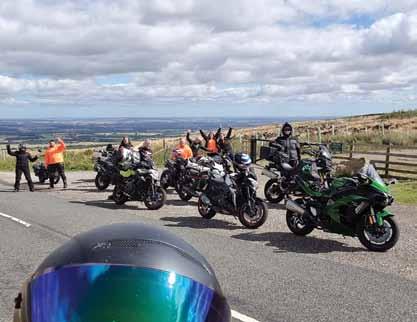
Back at fabulous Tutbury Castle for the second year, Helen and Cheryl set up the BMF stand and Sheonagh and volunteers from WIMA and Curvy Riders wo(manned) it. Around 1300 visitors came and it was a terrific day with loads of great speakers on travel, first aid, stunt riding and more, plus demo ride-outs and activities. Workshops included bike maintenance, self-defence (for both women and men, by BMF Rep Tiffany Coates), yoga, photography and hair care for bikers. The day was packed, huge fun and we were delighted to sign up several new members. Ladies, come and join us next year and bring your fella if you like – about 25% of attendees were guys and they were made very welcome.
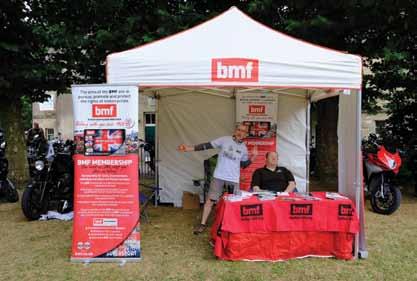 Sheonagh Ravensdale
Sheonagh Ravensdale
Calne Bike Meet is a not-for-profit event run by Calne Rotary, raising £10,000 for the chosen charities in 2019. Having recently volunteered as the BMF’s Dorset rep, I went along to represent us. I arrived to find motorcycles everywhere! Along the pavements, in the side roads and car parks. The whole of Calne seemed to be supporting the event, from tea and cakes in the town hall, to marshalling and a live band in the back of a lorry. Young children wore ear defenders while older residents reminisced about the bikes they had when younger. Back at the BMF gazebo, we had a number of interested parties including, I am glad to say, a few youngsters who had either just got a licence or were keen to do so. A very enjoyable day out, so thank you to the sponsors, the organisers and the people of Calne.
 Adrian Lambert
Adrian Lambert
Left: Motocamp: Parade of Nations arrives in Montelimar
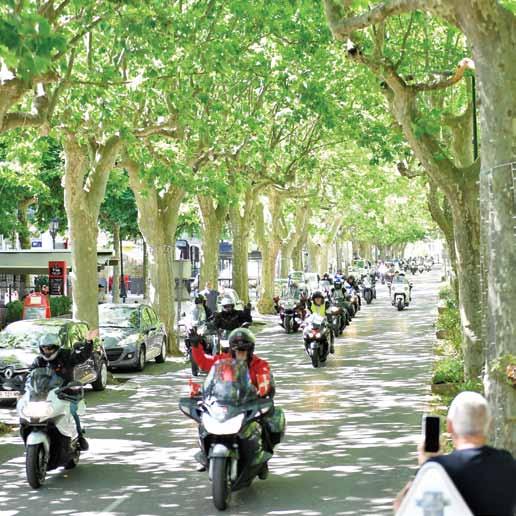
Below: FIM Rally: Arrival Control in Dessau

Increasing numbers of riders are taking their bikes abroad each year, as they look to widen their travel horizons, and one option is to take part in one of the FIM touring rallies. The FIM – the international governing body of motorcycling – franchises a number of these, the main ones being the FIM Rally, the Motocamp and Mototour. Organised in a different country each year, these allow riders from many nations to explore a different location each year, knowing the event will follow a standard format. All these FIM rallies are all-inclusive, with entry fees covering accommodation, breakfast, lunch and dinner (but not drinks...) and evening entertainment.
The FIM Rally offers both hotels and camping whilst Motocamp, as the name suggests, is camping only. Mototour is hotel-based and participants can follow a different route each day, visiting places of interest. Each event normally covers four days (three nights) but often the organisers will open facilities a day or two before the event officially starts, allowing riders to arrive early. Modern touring bikes may predominate, but anything goes – sports bikes, scooters and even classic machines all take part as well.
In recent years these events have taken riders to countries as diverse as Sweden, Italy, Germany, Croatia, Spain, Greece, Latvia and the Czech Republic, so quite a variety of directions to tour in. The BMF has recently taken over responsibility from the ACU for handling British entries to these events and full details of them, including entry fees and forms, will appear on the BMF website as soon as they become available.
This year Motocamp was held at Le Teil in the Rhone

Valley, south of Lyon, with 182 participants (155 riders and 27 passengers) enjoying camping in hot, dry weather. The heat wave continued for the FIM Rally where 503 participants had sunny conditions at Ferropolis near Dessau in eastern Germany. With Mototour being staged at Kavala on the coast of the Aegean Sea in Greece, predictably conditions were yet again sunny, with 158 riders from 16 countries, including Iraq for the first time.
FIM Rally – Zaragoza, Spain – 23rd-25th June
FIM Motocamp – Kaunas, Lithuania – 3rd-6th August
FIM Mototour – Djerba, Tunisia – September - Date TBA
what
rallies are, and why you should do one next year
Remember your first bike? Erm...yes, I certainly do because as I write this I bought it last month, April 2022! I had been thinking about getting a motorcycle for years but the chance came when I started travelling 15 miles to work in Sevenoaks, through beautiful scenery.
I bought a Honda CB125F, having completed my CBT on 31st December last year (the last person to do so at Crystal Palace test centre, I was told). The theory test followed and I hope to get a full motorcycle licence and a bigger bike soon.

Anyway, I had planned everything down to the smallest detail. Well, almost everything... When I came back home from the dealer on my shiny new Honda, I realised that the garden gate was too narrow! After 15 minutes of trying not to scratch the Honda, I figured out that entering at a certain angle would do the job. Success! Thankfully, my neighbour is a skilled builder and enlarged the entrance a few days later. This in turn encouraged me to paint the gate and the rest of the garden fence, which made everyone happy including my wife and the neighbour. I hadn’t even started riding yet but the many benefits of motorcycling were already stacking up.
“You will not want to go back to a small bike after you have tried a big one,” said my local dealer. Well, so far, I love riding this little 125 – it is just perfect. Did it change my life? Oh, yes!
Motorcycling has opened up a new world for Arek... and his kids

Apart from enlarging the gate and painting the whole fence, I am enjoying my morning ride to work. Better still, the Honda’s biggest fans are my kids – Mia (age six) and Nathan (two). Every morning, after wheeling the bike out of the garage, I ride around the block to the front of the house for the children to see me. We wave to each other for a good couple of minutes. When I come home, Mia and Nathan are waiting for me by the gate, desperate to climb on. It feels good, even better than riding itself…
“Welcome to the world of motorcycling!” said Paul from the dealer shop, handing the keys to me and shaking my hand. Yes, I am in this different world now that seems even more exciting than it did before I got on the road. I’ll be happy to report in the future how the situation develops. In the meantime, it might sound funny, but every day I look forward to riding to work – I just wish I had bought a motorcycle earlier.
Do you remember your first bike? Of course you do – tell us the story (in about 500 words, preferably with a picture) and we’ll print it in Motorcycle Rider. Send your My First Bike story to editor@bmf.co.uk
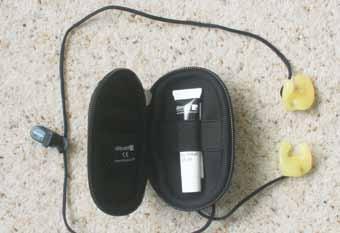
some tinnitus after 10 years of riding, so I started to look seriously into protecting my hearing. Friends were using Ultimate Ear customised earplugs and recommended them.
I bought a pair just before riding from London to Beijing via Tibet and Everest Base Camp, which would mean 12,000 miles of challenging riding, engine and wind noise. I was amused to realise just how much they resemble jelly babies – mine are brightly coloured. Locals were even more amused to watch me squeezing these jelly babies into my ears. They are comfortable and easy to use, and after that first three-month trip, I haven’t looked back and use them on every ride. I’ve maintained my hearing and the tinnitus has faded; doctors say my hearing is good, especially considering my lifestyle. I’m happy I started to protect my hearing before it was too late.
Not many of us need telling that earplugs are essential to help prevent long-term damage to our hearing, so of course I used them. But then my motorcycling changed (lower speeds, fewer miles, even fewer motorways) and I got out of the habit. Now I’ve got a new pair of plugs from Ultimate Ear Protection, and yes, I’ve been reconverted. They’re comfortable and cut noise down very effectively, including at lower speeds.
It was all done remotely, visiting my local audiologist in Yeovil for the impressions to be made, posting those off and receiving the plugs back a couple of weeks later. Not using phone or music on the bike, I’ve got the basic unfiltered earplugs, but I did opt for bright yellow ones – in the days before neck strings, the clear ones took some spotting if you dropped one on tarmac...
Peter HenshawAs the tens of thousands of miles added up, I realised that not only was my bike taking a beating, but my body was too – bones will heal and mend, but hearing doesn’t. I had already developed

 Tiffany Coates (BMF Cornwall Rep)
Tiffany Coates (BMF Cornwall Rep)
I recently bought the Ultimate Filtered earplugs. The whole process for choosing them, getting the ear impressions done and paying took around 15 minutes at an event. The plugs arrived a couple of weeks later. They were easy to fit and immediately comfortable. On the first ride, they were not as quiet as I expected, especially on exposed windy motorways, but they do take away the worst of the wind noise, which becomes bearable for long stretches. At A-road speeds they’re great – I can hear what I feel I need to, including my music, but wind and engine noise is reduced nicely. They stayed comfortable after long days (coming back from France after completing the Grande Alpes Route) and in varying weather conditions. The neck string helped me not to drop or lose them, and they were not affected by the damp when I left them in the handlebar bag on my bike, in overnight rain, which was a problem with my previous earplugs.
Caroline Lunnon (WIMA GB, President)Words: Mary Lomas
It has been fabulous to see so many of you out and about at events this year. We started the year with the Manchester Bike Show and have just enjoyed the Stafford Classic Bike Show. In between we have participated in the Staffordshire Biker Breakfasts, men’s mental health events, club concours, more classic bike shows, a day in Matlock, and (my personal favourite) a pizza night at Manchester Triumph Club.
Our sponsored athletes have done us proud this year, as ever, with Team Thorneycroft 56 headed by Bradley Wilson going from strength to strength. Christian Iddon is as committed as always, while Harry Turner has shown us what he is made of in trials, and Belle Vue aces absolutely smashed it by becoming this year’s champions.
We have also had the honour of supporting the BMF, Mental Health Motorbikes, Staffordshire Doc Bikes, and Upright Derbyshire. The work these organisations do on behalf of riders is incredible. Ultimately their aim is to support and help bikers to ride safely and happily. The biking community is quite unique in the friendship, support and freedom it brings and these organisations all demonstrate this.
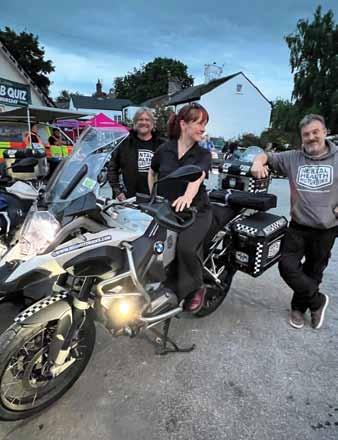
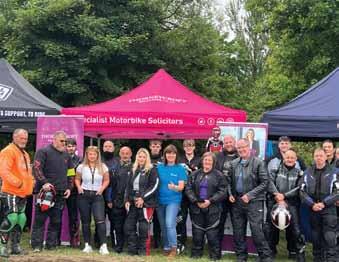
Hopefully you have all stayed safe on the road. I think it’s fair to say that the roads are busier than ever after the pandemic and people seem to be less aware of each other. We will continue to promote biker safety and support the charities that help riders. Thorneycroft Solicitors are taking part in BRAKE week (road safety charity) again in November and part of the campaign will be to encourage people to THINK BIKE!
The autumn is mild so far so if you are still out and about on your bike, make sure you think about the changing conditions such as low sun, darker nights (and days) and slippery road surfaces. Make yourself visible. Also think about doing an advanced riding course (it’s saved the life of one of my clients), or a Biker Down course, over the winter.
If you have been involved in an accident, and believe that someone else may have been responsible, then please do give us a call to discuss how we can help you.
Don’t forget that we also do wills, probate, powers of attorney, trust, family law, conveyancing, employers and public liability, and clinical negligence. Please do get in touch if we can help you over winter – it’s a good time to get your affairs in order.
Finally, we will see you all next year, out and about. If any clubs would like us to attend to do a talk over winter, then please do let us know – Marylomas@thorneycrofts.co.uk. Thank you for all of your support this year.
Located on the Highland boundary, at the intersection of several glorious rural A roads, the Perthshire town of Crieff is a wonderful base for day rides. You'll discover four of my favourites in the Crieff Cloverleaf (www. cloverleaf.scot), with maps, GPX and waypoints all freely available from the website.
single-track roads, travelling southwards to the end of Leg 2 at Nethybridge. Leg 3 also starts out on small roads, running south through a variety of landscapes from moorland to farmland to pine plantations and lush broadleaf forest. Watch out for some amazing views of the highest Cairngorms across to the east!
Ride Cloverleaf North Maps, GPX and waypoints available at: www. cloverleaf.scot/gmap

For sheer riding joy, my go-to route is the Cloverleaf North (225 miles and about six hours riding time). Like all the Crieff Cloverleaf routes, this is divided into four separate legs. Leg 1 heads north from Crieff through the dramatic Sma' Glen, and upwards through moorland and forestry into Highland Perthshire. Enjoy wideranging views across mountain ranges as you crest the final hilltop, before beginning a twisty descent down into the pretty town of Aberfeldy.
From Aberfeldy, the route winds westwards towards Highland Scotland's backbone road, the A9, crossing it and heading up onto high moorlands east of Pitlochry. Following a delightfully meandering single-track road to Kirkmichael, the route then turns north to join the twisty Snow Roads route, up through the Glenshee ski resort (temperatures will drop here!) and on down to the end of Leg 1 at Braemar.
What’s your favourite day ride? tell us about it in 500 words with a few pictures (high resolution please). You could see it later in Motorcycle rider and receive a BMF gift! Send to: editor@bmf.co.uk

Leg 2 initially heads north and west from Braemar. Before Tomintoul it's a mix of sweeping A road and twisty narrow B road. The Cairngorms mountain landscape here is bare and breathtaking, while one riding highlight is the gravity-defying climb up a manically steep A939 to reach the Lecht ski centre – it's bonkers!
After Tomintoul the route switches to minor


After a dandle around Loch Insh, Leg 3 joins the A9 southbound near Kingussie for about 20 minutes, travelling up over the dramatic and moody Drumochter Pass (regularly closed by snow in the winter.) Sit back and enjoy the uncomplicated, wide, single- and dualcarriageway here, because Leg 3 soon leaves the A9 again, above Trinafour, for some exceptional mountainous single-track riding. This remote stretch of road is fully paved, but can be a bit rough in places. It also has some steep downhill hairpins, so don't get too absorbed by the magnificent scenery! The road snakes down to join the waterside B846 into Kinloch Rannoch, the end of Leg 3.
Leg 4 departs Kinloch Rannoch and takes the exhilarating rollercoaster single-track of Schiehallion Road across the moors, eventually joining wider B roads and then flowing A roads back to Aberfeldy. (Look out for the town of Dull, twinned with Boring, Oregon!) From Aberfeldy, it's a final flowing ride back up over the hill, through the Sma' Glen and home to Crieff. Look out to the west as you're coming down the A822 into Gilmerton on the final stretch – the view over Crieff and Strathearn to western mountains is one of my favourites in the world!

Sarah Anderson was presented with the Margaret Wells Memorial Award on 23rd October at Mallory Park. Since making her race debut in 2011 she has taken part in many road races in the UK, Ireland and on the Continent, with a variety of machinery including a KTM-powered Kramer Supermono. In 2019 she finished 10th and 9th in the Manx GP Ultra Lightweight races with a race average of over 100mph, a fortnight after suffering concussion when her Honda 125 had an engine seizure. Sarah was awarded the Lesley Anne trophy for top female racer.
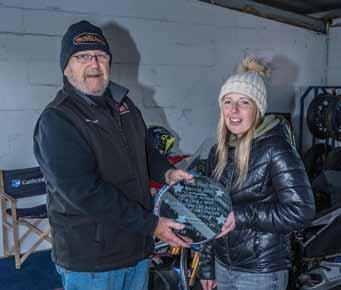
Many BMF members will have known Ken and Margaret Wells, both stalwarts of the club ever since its 1960 inauguration. After Margaret’s passing, Ken suggested creating the Margaret Wells Memorial Award, presented annually to a female BMF member for a significant contribution to motorcycling.
Ken and Margaret had a long association with Mallory. They were both involved in helping to run race meetings for many years, Ken as one of the paddock marshals and Margaret working in the race office.When I took the award over to Ken to get his
approval, not long before his own sad passing, he mentioned how Margaret had taken a certain Italian racer under her wing and assisted him with his paperwork. Apparently he never forgot this and whenever he rode at Mallory, a box of Italian chocolates appeared as a thank you. It seemed to be more than coincidence that John Cooper was presenting the awards on the day, as his battles with Agostini are legendary.
Mitch ElliottThanks to Dave Chapman (photographer) and to Paul Fincham for supplying and etching both the main award and the replica. Also to Howard Anderson for additional information.






























he great thing about long-distance motorcycle travel is that amazing things sometimes come from small but practical ideas. This is very much how the charity Motorcycle Outreach (MoR) came about. In this case, the vision was about delivering primary healthcare in remote areas of developing countries, where roads are poor or barely exist, via small motorcycles. Overland traveller Simon Milward developed his ideas for this in 2001 on the Indonesian island of Flores after he met a local aid worker there called Willy Balawala.
Simon is a significant part of riders’ rights history. During the 1990s, he was the general secretary of FEMA and led many of the great motorcycle campaigns of that era – against 100bhp limits, EU rider licensing and the regulations which became type approval, amongst others. In many ways he ‘wrote the book’ about how to
Tcampaign successfully for motorcycling. In 1999, he set off on a round the world motorcycle trip which would last for several years, during which he developed the idea which became Motorcycle Outreach (MoR).

The idea was not completely new – the former charity Riders for Health operated similar projects in Africa and Simon was inspired by these. He felt that a similar model for supporting remote communities could be utilised elsewhere in the world.
After visiting Indonesia as part of his ride, Simon focused his travelling fund-raising efforts towards a new Indonesian project which is locally called the Health for All (HfA) project. He arranged for Willy Balawala to be trained in project management and also Transport Resource Management (TRM), which is the method for ensuring the bikes remain reliable long term.
Simon’s fundraising was used to develop the project, which is based in East Nusa Tenggara – an island region which includes Flores. Twelve motorcycles were purchased to enable mobile units of Health Ministry workers provide the more remote populations in the region with primary health services. The initial results were dramatic. In one area, child malnutrition dropped from 167 cases to just 27 in seven months after the introduction of motorcyclebased healthcare logistics. HfA provides primary healthcare transport for a catchment area of over 50,000 people living in over 50 villages in Flores.
Tragically, in March 2005, Simon lost his life in a road accident near Kayes, Mali, towards the end of his round the world journey. His family and close friends jointly decided to continue the MoR mission that Simon had so enthusiastically started and in July 2005

Motorcycle Outreach was officially constituted as a UK charity.
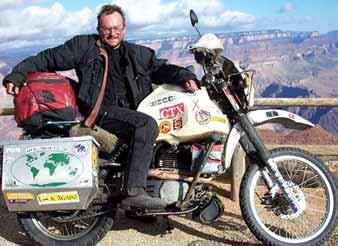
MoR’s vision is to ensure that no human being living in remote communities of developing countries shall be denied access to basic healthcare services simply because of their location. Often people in Low and Middle Income Countries (LMIC) are at a higher risk due to their remoteness from a health care specialist or medical centre and the lack of adequate transport resources. Motorcycle Outreach envisions that healthcare support in LMIC can be mobilised in a reliable, flexible and economic way in order to make a significant impact on the health, quality of life and prosperity of outreach communities.
The MoR system is simple. Using locally-trained technicians, MoR supported projects manage and control the roadworthiness of motorcycle fleets based on the ‘zero breakdown’ principle. This includes managing spares for preventative and corrective motorcycle maintenance. Healthcare workers are trained to ride safely and how to look after their bikes, including on-going daily checks. So in essence, what MoR does is to fund healthcare transport logistics, but to a model which delivers maximum benefit for those people who really need it.
Motorcycles are of course used for aid activities elsewhere. But often these are bulk purchased for various projects, used for a year or so, not maintained properly and then dumped. This is both wasteful and unsustainable. We see the same with fourwheeled transport and it’s not unusual in some parts of Africa to see vehicles just a few years old being used as chicken sheds. Something breaks, parts aren’t available, no one knows what to do and the vehicle falls into disuse. MoR’s model of managed transport meant that the original 110cc Yamahas lasted until 2014 – just over 12 years – before they were replaced. Not bad, given the dire state of some remote roads and tracks.
MoR isn’t just about transport, and in Indonesia, the HfA project also organises seminars and group discussions on reproductive health, nutrition, STDs, HIV/AIDS and helps with the supply of health education materials for distribution.
In 2010 the Indonesian project won the SATU Indonesia award for its innovative approach and contribution to health care improvement in the region. Since then several other awards and other recognition have followed, and HfA continues to develop as a local aid agency, with funding for various projects also coming from other major aid organisations and sponsors.
MoR continues to support the HfA project in Indonesia, but has recently been considering the future in more depth. The pandemic had a major effect on fundraising activities, but it also provided an opportunity to assess where the charity goes next.
As a result we are looking to develop the management team and build fundraising and day to day activities so that we can develop new projects. Northern India has been earmarked, as have parts of South America, and MoR is currently developing a new plan which will take the charity forward into its third decade since Simon Milward first put his vision into action.
Above: Simon Milward’s vision saw MoR get off the ground
Below: Motorcycle Outreach has had a dramatic effect on local health in Flores
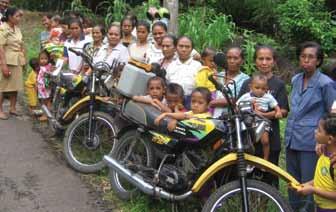
Support is always warmly welcomed and MoR is very grateful for this. To find out more about Motorcycle Outreach and how you can offer support, simply visit the website at www.motorcycleoutreach.org If you’d like to discuss MoR further then please mail info@motorcycleoutreach.org
In the Spring 2022 issue of Motorcycle RIDeR, we covered the excellent work of Talan Skeel Piggins’ charity, which helps disabled people to get back onto bikes. Back then the charity was in danger of closing – where is it now? we asked Talan for an update.
“we are still here but we now need your help. I have managed to engage the services of a fund-raising company to help the charity continue beyond 2022. what we need are Vice Patrons (those in senior positions, the famous, mayors, MPs). If you know someone then please email me (tskeelspiggins@hotmail.com). The fund-raising company can then send them a letter on behalf of the charity, not asking for money, but for their support. It is thanks to DSA and their founder Mike wood for the contact that has led us to getting the help from the fundraisers. The plan is to survive 2022, and raise funds so that we can run instructional events again in 2023. I’m very excited to have been able to weather this storm.”


– 10% discount applied at checkout if you order before 15th December. (Does not apply to Weebles T-shirt or membership packs)

n Weebles T-shirt £22
We asked Weeble of Weeble's World to come up with a new design to symbolise our ‘for all’ ethos and we are blown away by it….
10% of all sales will be donated to Mental Health Motorbike.
Available in unisex sizes M –3XL
n Membership gift voucher packs – available for individual or joint members £28/£34.

Voucher valid for 12 months from purchase, memberships valid for 12 months from voucher activation
n BMF for ALL (helmet) T-shirt £15

This luxury-feel Lady-Fit T is a comfortable classic that helps you look effortlessly elegant and its 100% cotton fabric feels beautifully soft and cool. When you want a fitted T-shirt that looks fabulously flattering, look no further.
Available in sizes 8 – 18
n BMF logo visor cleaning cloth £3.50

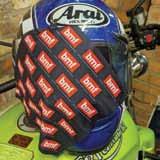
Comes with a handy pouch
n BMF logo Neck tube £4.50
Seamless and can be worn in various ways. Machine washable
n Handy bottle opener key ring £3.50
Available in black or red
n BMF logo gel bike keyring £2.50


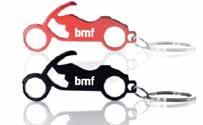
Super soft, ideal for protecting paintwork
n BMF logo tyre tread gauge £4.00
Perfect for keeping a regular eye on the treads
We are the original, the first Sikh Motorcycle Club UK. Its roots lie in 2018, when a group of strangers met while supporting a Bike for Life event at RAF Cosford. Not knowing each other but having a mutual passion for motorcycles and wearing a Dastar (Turban), they soon became friends. In 2020 they decided to set up a Facebook page to see just how much interest there would be in forming a group. As you may be aware, riding a motorcycle in the Punjab region of India is very common, but not so much in the UK for Sikhs. But as word spread, the Facebook page grew, attracting people from all walks of life, religion and colour, not only Sikhs. The club grew from there.


oneself, thus living as an inspiration and support to the entire community). We are all aware of how tough the Covid situation was, and it impacted on everyone in different ways. During the pandemic the NHS was running short of face masks, face shields and scrubs. HOPE, a charity, supported the need to protect the extraordinary NHS key workers by making face masks and scrubs for free. To help out, our club members volunteered to transport materials across the country to those making this PPE. We also supported a local company by assembling face visors and posting them out.
We support other charities, such as MLS (Midlands Langar Sewa), which provides hot meals in the Midlands to those who are less fortunate, Monday to Friday, all year round. Some members also contribute to other charities, not only in the UK but abroad too.
Contact:
www.sikhmotorcycleclub.uk Instagram (SIKHMCUK)
When we are out on rides, we often get asked why we are allowed to wear a Dastar when riding. The answer is simple: In November 1976, Her Majesty the Queen gave her Royal Assent to a Bill to exempt turbaned Sikhs from having to wear crash helmets when riding a motorcycle. The Bill was accepted after Sydney Bidwell MP had argued that many Sikhs fought for the British Army and they had not been required to wear additional safety gear in wartime. If Sikh people had been willing to die in the name of the British Empire he argued, Britain should not ask them to break one of their primary religious commandments in order to ride a motorcycle. He also argued that leeway was already allowed in other areas, such as Sikhs wearing personal protective equipment in factories.
The Sikh religion has three pillars, one of which is Vand Chakna (to share the fruits of one's labour with others before considering
More recently the club has gone from strength to strength, growing in numbers and creating a new logo and website as well as Instagram posts, with club wear such as jackets and badges to increase awareness. We also became a member of the BMF family. Ride-outs this year included the Bike for Life (Midlands Air Ambulance) event, and supporting prostate cancer awareness at the Distinguished Gentleman's Ride. We believe in equality and humanity and encourage those from other backgrounds, faiths, colour and gender to join us on this journey on two wheels. A teaching from the first Sikh Guru, Guru Nanak Dev ji was:
“Manas ki jaat eke penchavo,” which translates “All mankind should be treated equally, you should not discriminate against anyone’s belief, colour or gender. Guru ji also said: “Women gave birth to great emperors and warriors.”
So that is us, the Sikh Motorcycle Club UK. Please keep an eye out on our website and social media pages for further information about upcoming events, ride-outs and meets.


Vlogger and Bikesure ambassador UsernameKate, AKA Kate Ralph, details five of the best motorcycle YouTubers and influencers serious bikers should be aware of.




Bruce Smart AKA TeapotOne exploded onto the scene after riding a Suzuki GSXR1000 sport bike a staggering 74,000 miles on a solo adventure around the world. Bruce tackled 54 countries in 442 days.
Bruce’s most recent content includes adventures, challenges, meeting new and interesting ‘folk’, reviewing gadgets and riding and reviewing motorbikes.
44Teeth
44Teeth is brought to you by Chris Eades (AKA BaronVonGrumble), Alastair Fagan and their newest addition to the team, Mike Booth. The trio bring spice and speed to motor journalism.

This motorcycle-related YouTube channel is akin to sitting in the pub with your mates enjoying unfiltered and unregulated biker banter. Some of my favourite series from this channel are their Budget Bike Battles which are hilarious and their News show, which I guarantee will have you in hysterics.
Alberto Naska
Naska shares racing insights that not many people get to experience. The man is fast and not only does he race motorcycles, but he also explains beautifully how to improve your track riding.


He is Spanish but has a dedicated English-speaking channel called Alberto Naska EN, and the effort he puts into this channel is just charming.

Informative and entertaining, he is an extremely charismatic Spaniard and keeps my eyes glued to the screen.

‘Chopsy’ is one of my all-time favourite motorcycle YouTubers. He’s a man teetering on the edge of obtaining his silver play button for hitting 100,000 subscribers and his following could not be more deserved.
A wonderful ‘tell it how it is’ YouTuber with an impressive stable, he currently owns a Kawasaki H2, a Ducati Hypermotard 1100 and his most recent addition, an extremely clean GSXR1000.
In Chopsy’s vlogs, you’ll find bike reviews, gear reviews, adventures, experiences, and bike builds and modifications.
Noraly, who goes by the name Itchy Boots, started her channel in November 2018 and has since amassed more than one million subscribers.
She took the extremely brave decision to sell everything she owned, buy a motorcycle, travel around the world and document it in a series on her YouTube channel.
I know the effort that goes into being a ‘motovlogger’ and I am honestly in awe of this incredible woman, who edits on the move and pumps out three vlogs per week.



No matter which YouTuber you love watching, when you get out on your bike you’ll need motorcycle insurance you can be confident with. Thankfully, Bikesure can offer you a great deal and a discount of up to 25% for BMF members. Call 0808 503 3275 for a no-obligation quote or book a callback at a time that suits you.

The BMF held its AGM on 10th October 2022, at 10am. The event, held on Zoom for the third time, was a great success with members taking part from both clubs and as individuals.
Regular business was dealt with briskly, before moving on to wide-ranging discussions on a number of topics. The meeting heard reports from the Chair, Jim Freeman, and fellow Directors: howard anderson, Finance
Peter Laidlaw, Membership Services
Sheonagh ravensdale, Communications
anna Zee, Political & technical Services
The meeting was run by Jim Freeman, who managed the polls and voting, with help from Helen Hancock, the BMF’s Administrator, particularly monitoring the lively chat board.
Jim Freeman was re-elected as Chair with 89% of the votes cast on a Zoom poll.
The meeting ratified all the following posts en bloc, via the nominated list: BMF Councillors and Regional Chairs and the Chair of the National and One Make Clubs (NaOMC), elected via Annual Regional Meetings (ARMs) and the National and One Make Clubs (NaOMC) forum. The ARMs and NaOMC were held for the first time since 2019, because of the pandemic, returning the BMF to its normal democratic process.
The meeting also approved the accounts for BMF (Enterprises) Ltd for 2021.
Key topics raised and discussed at the meeting included the BMF responses to the following consultations, and other essential lobbying activity:
• Creation of a Road Collision Investigation Branch (RCIB).
• The Future of Transport Regulatory Review: Modernising Vehicle Standards.
• When to end the sale of new non-zero emission L-Category Vehicles (commonly referred to as decarbonisation).
• Improving air quality and Londoners’ health, climate change and reducing congestion (commonly referred to as the ULEZ consultation).
• Remote Driving issues (consulation by the Law Commission).
• The National Motorcyclists Council’s (NMC) work in building relations with government, with the overall objective of full motorcyclist inclusion in the Government Transport Strategy, involving the Department for Transport (DfT), Home Office and Cabinet Office.
Topics discussed concerning the BMF itself:
• Changes in BMF Communications strategy and their implementation.
• BMF’s financial situation and future. The increase in revenue from expanding membership, together with a substantial surplus in 2021, allowing for the employment of a Government Relations Executive (GRE).
• Successful renewal of the BMF events programme, both the BMF’s own events and those attended externally. The annual Dambuster Rally, reported elsewhere in this issue, has gone from success to success, with a maximum capacity sell-out this year.
• Ongoing successful partnership with Bikesure.
• Partnership with Thorneycroft Solicitors, who provide the BMF Legal Line, also supporting road safety organisations.
• BMF Breakdown recovery scheme, as a significant member benefit.

Finally, the Chair, Jim Freeman, stressed that the BMF were committed to maximising lobbying effort within the available resources, including employing a full-time Government Relations Executive (GRE) for the first time since 2016.
The Chair closed the meeting at 1.20pm, after announcing 14th October 2023 as the next AGM, venue to be confirmed.
REGION 1 – SCOTLAND
regional Chair - Tom Duncan 01506 842131, 07887 835321 tom@tomduncan.co.uk
aYrShirE - Pauline Speirs
01560 321791, fastrakscotland@aol.com
GLaSGoW - Nick Elliott 01416 379305 drnickelliott@gmail.com
REGION 2 – NORTH EAST
BiNGLEY - John Lancaster 01274 560174, john-lancaster@sky.com Tina Walker, 01377 217242
WESt YorKShirE - Alex Parsons-Hulse 07702 229 311, alexparsonshulse@gmail.com
REGION 3 – MIDLANDS
CovENtrY aND WESt MiDLaNDS John Nelson, jsnlsn@btinternet.com
DErBYShirE - John Hutchinson
07876 756 356 hutchpeaks@btinternet.com
WarWiCKShirE - Mark Lunt 07767 870117, mark.a.lunt@gmail.com
NottiNGhaMShirE
Jerry Hough, 07825 997969 jerry.hough@mail.com
hErEForD aND WorCEStEr
Frank Whittaker, 01531 635843 frankwhittaker62@gmail.com
ShroPShirE - James Ellerby jamesellerby@btinternet.com
StaFForDShirE - Jeffrey Brook 07401 070 934 jeffbrook89@outlook.com
REGION 4 – EAST ENGLAND
CaMBriDGEShirE
Tim Flinders, 01223 212721
REGION 5 – LONDON
South London Charles Deakin 07951 978 283, Deakie57@live.co.uk
REGION 6 – SOUTH EAST
BErKShirE - John Ward 01344 428667, 07880 645970 john.c.ward@hotmail.co.uk
haMPShirE - Ian Hammond 07989 531121 iphamonda@googlemail.com
KENt - Mike Gallafent 01322 400775, 07503 165035 michaelgallafent@yahoo.co.uk
oXForDShirE - Hugh Jaeger 01865 554814, 07762 093310 hugh_jaeger@hotmail.com
West Sussex - Mark O’Dwyer 07824 554 927 markodwyer67@gmail.com
REGION 7 – SOUTH WEST
regional Chair - Jim Peel-Cross 01249 819671, 07470 899546 jimpcross@hotmail.co.uk
Deputy Chair - Adrian Lambert 07971 908 604 adrian.lambert@mac.com
Bath - Carenza Ellery 01225 835599, 07962 076370 (text preferred) cbx550mini@gmail.com
CorNWaLL - Tiffany Coates 07805 078062 tiffanycoates@hotmail.com
WESt WiLtShirE - Les Simper 07789 354371 leslie.simper@btinternet.com
SoUth WiLtShirE - Roger Stone 07928 822671 r.stone703@ntlworld.com
REGION 8 – WALES
CENtraL WaLES Phil Harries, 07968 168486 dpharries1@aol.com
SoUth WaLES - Steve Preston 07906 167 357 steve@stephenjpreston.com
REGION 9 – NORTH WEST
regional Chair - Peter Laidlaw 07939 260524 peter.laidlaw@ntlworld.com
ChEShirE - Jim Bradburn 01606 836782 jimbradburn@hotmail.co.uk
CUMBria - David Kershaw 01697 742 201 david.kershaw@bmf.co.uk
EaSt LaNCaShirE
Mick Gibbons, 07940 816492 mick.gibbonsindarwen@googlemail.com
Steven Bartley, 01254 278187 ste.bartley@googlemail.com
WESt LaNCaShirE - Dave Barton 01772 455018, 07971 519004 bmf_r9@notrab.co.uk
REGION 10 - NORTHERN IRELAND

regional Chair - Howard Anderson 07918 903497 howand@hotmail.co.uk
CO. ANTRIM - David Gillespie (club liaison) 02893 350495, 07882 525777 gwocni@hotmail.com
COUNCILLORS
R1 - Kona Macphee, 07747 651 877 kona@cloverleaf.scot
R2 - Alex Parsons-Hulse 07702 229 311 alexparsonshulse@gmail.com
R3 - Mitch Elliott, 07982 802 588 elliott.mitch@gmail.com
R5 - Juergen Buechner, 07786 931 729 jwbuechner@mail.co.uk
R6 - Norman Powers, 01635 254 154 pollard1942@mail.com
R6 - Neil Smith, 07961 576 624 gunnersmith1959@gmail.com
R7 - Adrian Lambert, 07971 908 604 adrian.lambert@mac.com
R9 - Anthony Beard, 07944 661 779 anthonybeard@blueyonder.co.uk
R10 - David Gillespie, 07882 525 777 gwocni@hotmail.com
Note that all Regional Chairs and Management Team are also Councillors
NATIONAL AND ONE-MAKE CLUBS (NaOMC) FORUM COUNCILLORS
Chair - Stephen Davenport Honda Owners Club stephendavenport98@me.com
Secretary - John Gardner Triumph Owners Motorcycle Club 01695 622792 john.gardner119@gmail.com
tim Kirker Vincent H.R.D. Owners Club tim.kirker@zen.co.uk
Jacqueline Bickerstaff Vincent HRD jacqueline.bickerstaff@btinternet.com
John Nelson Triumph Owners Motorcycle Club jsnlsn@btinternet.com
John Nicholas Ducati Owners Club GB bmfrep@docgb.net
Pete Wilson BSA Bantam Club Secretary@bsabantamclub.org.uk
USEFUL CONTACTS INCLUDING MANGAGEMENT TEAM (MT)
Jim Freeman, BMF Chair (MT) jim.freeman@bmf.co.uk
Sheonagh Ravensdale, Communications Director (MT) sheonagh.ravensdale@bmf.co.uk
Peter Laidlaw, Director of MemberServices (MT) peter.laidlaw@ntlworld.com
Howard Anderson, Finance Director (MT) howand@hotmail.com
Anna Zee, Political & Technical Services Director (MT) anna.zee@bmf.co.uk
Emily Rochester, Government Relations Exec emily.rochester@bmf.co.uk
Cheryl McMonnies, Membership Secretary membership@bmf.co.uk 0116 2795 112
Helen Hancock, Admin & Anything! admin@bmf.co.uk 07918 903 500
MORE BMF REPS NEEDED!
If your county is not listed and you would like to be a BMF rep, we would love to hear from you - please email admin@bmf.co.uk

WRONG NUMBER?
If these aren’t the right contact details, let us know at admin@bmf.co.uk and we’ll put it right.
A COMBInEd 2-In-1 WASh & dEGREASER FOR ALL OVER CLEAnInG!


FREE
Ideal for removing traffic film and road muck along with, grease, lubricants, brake dust and oils, Clean MyRide’s non-streak formula delivers superb results without damaging surface finishes, paint, plastics or metals including aluminium, alloys, chromed and anodised components. Simply mist onto surfaces, leave for a few minutes, agitate if necessary and wash off.

Check out our 5* reviews on our website, Facebook and Google and discover the effortless way to keep your bike spotless and gleaming with just one product!



SOLVENTS • EcO FRiENDLY

3690 MILES WORTH OF EUROPEAN ROAd GRIME, bUG SPLATS, TAR SPOTS ANd OFF-ROAd GUNK GONE, THANKS TO CLEAN MYRIdE CLEANER & dEGREASER. SUPERb PROdUCT…MORE EFFECTIVE THAN OTHER bRANdS ANd MUCH CHEAPER TOO. THE RESULTS SPEAK FOR THEMSELVES!

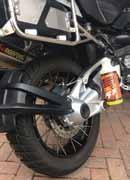
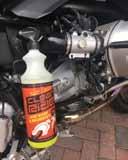

A SPOT OF VALETING FROM EARLIER THIS WEEK. CLEAN MY RIdE IS HONESTLY THE bEST bIKE CLEANER I HAVE USEd IN MY THIRTY YEARS IN THE bIKE TRAdE.
5*Reviews
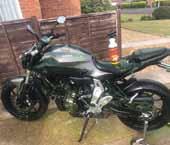
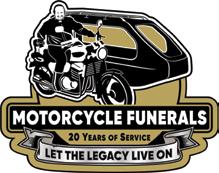
Motorcycle Funerals we create an alternative send off for your Special Someone. Our fleet serves England, Scotland, Wales, Northern Ireland, and includes Isle of Man, Channel Islands, Isle of Wight, regardless of weather, we will be there in rain or snow, with our weatherproof sidecar hearses, as we have for 20 years. Even during the current pandemic, we have strived for funeral service excellence and travelled across the UK to make sure everyone has a safe, celebrated and dignified final journey.
